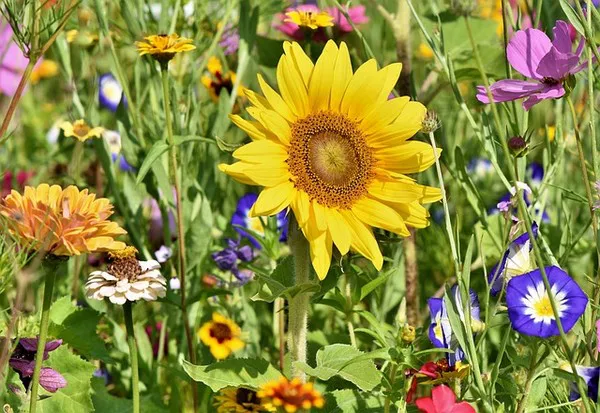Sunflowers (Helianthus annuus) are not merely vibrant blossoms adorning gardens and landscapes; they are botanical marvels that captivate with their towering stature and cheerful countenance. In this article, we will delve into the intricacies of the sunflower plant, exploring its distinctive features, life cycle, and the remarkable biology that contributes to its iconic appearance.
Anatomy of a Sunflower Plant
Sunflowers, characterized by their large, vibrant blooms and robust stems, are renowned for their phototropism – the ability to follow the sun’s movement across the sky. Standing tall, these plants can reach towering heights of 5 to 12 feet, depending on the variety and growing conditions. The sunflower’s anatomy comprises various components, each playing a crucial role in its overall structure.
Roots:
Beneath the soil surface, an extensive root system supports the sunflower plant. These roots anchor the plant securely, providing stability as it grows. Additionally, they absorb water and essential nutrients from the soil, contributing to the plant’s overall health.
Stem:
The sturdy, cylindrical stem of the sunflower serves as a conduit for water, nutrients, and sugars produced during photosynthesis. As the plant grows, the stem elongates, allowing the sunflower to reach impressive heights. A characteristic trait of the sunflower’s stem is its rough texture, caused by small hairs that cover its surface.
Leaves:
The leaves of the sunflower are broad, simple, and arranged alternately along the stem. Their surface is rough and covered with tiny hairs, contributing to the plant’s resilience. Sunflower leaves play a pivotal role in photosynthesis, harnessing sunlight to convert carbon dioxide and water into sugars, which serve as the plant’s energy source.
Flower Head:
The quintessential feature of the sunflower plant is its large, showy flower head. Comprising numerous individual flowers, the flower head is surrounded by petal-like ray flowers, which can range in color from bright yellow to deep orange. The central disk flowers, densely packed in the flower head’s center, are responsible for seed production.
See Also Can You Eat Sunflower Petals? A Culinary Adventure
Life Cycle of a Sunflower
Understanding the life cycle of a sunflower provides insights into its growth stages, from seed germination to the production of seeds for future generations.
Seed Germination:
The life cycle begins with the germination of sunflower seeds. When planted in well-drained soil with sufficient sunlight, water, and warmth, a tiny sprout emerges from the seed. Over the next few days, the seedling grows, developing its first set of leaves.
Vegetative Growth:
During this phase, the sunflower plant focuses on growing its stem, leaves, and root system. The leaves increase in size, and the stem elongates, preparing the plant for its ultimate towering stature. This vegetative growth stage is crucial for the plant’s overall development and energy accumulation.
Budding Stage:
As the sunflower matures, it enters the budding stage. The formation of flower buds is a visual sign that the plant is transitioning from vegetative to reproductive growth. The tightly closed buds gradually unfurl to reveal the vibrant array of ray and disk flowers that make up the iconic sunflower bloom.
Flowering Stage:
The flowering stage is the pinnacle of the sunflower’s life cycle. The radiant bloom attracts pollinators, such as bees and butterflies, which facilitate the transfer of pollen between flowers. This cross-pollination is vital for the production of seeds within the central disk flowers.
Seed Maturation:
Following successful pollination, the disk flowers develop into seeds. The once vibrant flower head transforms into a seed head, and the seeds mature within the protective structure. The seeds, nestled in the intricate pattern of the disk, are the culmination of the sunflower’s reproductive efforts.
Seed Dispersal:
As the sunflower plant completes its life cycle, the mature seeds are dispersed by various means. Birds, wind, and gravity all play roles in carrying the seeds to new locations, ensuring the potential for new sunflower generations to take root.
Biology Behind the Sunflower’s Appearance
The captivating appearance of the sunflower is not only a result of its size and color but is deeply rooted in its biological mechanisms.
Phototropism:
Sunflowers exhibit a fascinating behavior known as phototropism, wherein the flower heads follow the movement of the sun across the sky. This ensures that the maximum surface area of the flower is exposed to sunlight, optimizing the process of photosynthesis.
Heliotropism:
In addition to phototropism, sunflowers also display heliotropism – the ability of the flower heads to track the sun’s position throughout the day. While the flower bud is in its early stages, it actively faces east in the morning and turns westward in the evening, a behavior that ceases once the flower reaches maturity.
Pollen and Seed Production:
The central disk flowers of the sunflower are densely packed with both male and female reproductive organs. This unique arrangement facilitates efficient pollination and seed production. The disk flowers are surrounded by the ray flowers, which, despite their petal-like appearance, are sterile and do not contribute to seed formation.
Conclusion
In conclusion, the sunflower plant is a botanical masterpiece, showcasing not only aesthetic beauty but also a complex and adaptive biology. From its towering stem and broad leaves to the iconic flower head that follows the sun’s trajectory, every aspect of the sunflower contributes to its distinctive appearance. Understanding the life cycle and biological mechanisms that underpin this plant’s growth enhances our appreciation for its role in nature and its symbolic significance in various cultures. As we witness the sunflower’s journey from seed to radiant bloom, we gain insight into the resilience and versatility that make this plant a cherished and enduring symbol of natural beauty.


